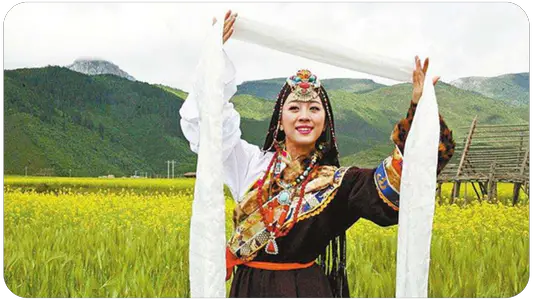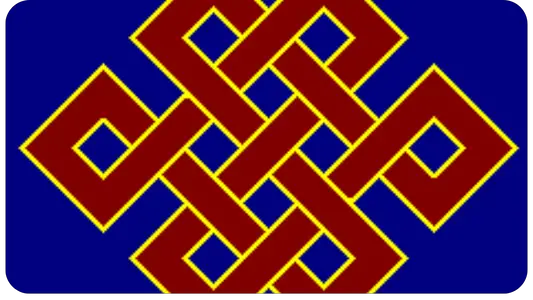Uppalavanna (in Pali Uppalavaṇṇā; in Sanskrit Utpalavarṇā; Savatthi, ... - 5th century B.C.) was one of the Buddha's two main disciples, along with Khemā.
At birth she was given the name Uppalavanna, meaning "color of a blue water lily," because of the bluish color of her skin.
According to Theravada tradition, Uppalavanna was born the daughter of a wealthy merchant. Because of her beauty, numerous rich and powerful suitors came to her father to ask for her hand in marriage.
Instead of marrying, she entered monastic life under the auspices of the Buddha as a bhikkhuni (nun). According to mulasarvastivada tradition, Uppalavanna had a tumultuous life as a wife and courtesan before converting to Buddhism and becoming a bhikkhuni.
Uppalavanna attained enlightenment by using a fire kasina as a meditation object less than two weeks after her ordination. After her enlightenment she developed mastery of iddhipada, or spiritual powers, which led the Buddha to declare her his chief disciple in matters of psychic powers. Her male counterpart was Maha Moggallana.
Sources
The earliest known record of Uppalavanna comes from a stone carving from the 3rd century B.C., which depicts her during the Buddha's descent to Sankassa after visiting his mother in Tavatimsa as described in Buddhist legend.
Uppalavanna is mentioned in several ancient Buddhist texts of the Pali canon, including the Saṃyutta Nikāya, the Aṅguttara Nikāya and the Therīgāthā and Apadāna collections within the Khuddaka Nikaya, as well as some early Mahayana texts such as Perfection of Wisdom in Eighty Thousand Verses and Treatise on the Great Perfection of Wisdom.
Buddhist scholar Bhikkhu Bodhi notes that although she is considered one of the Buddha's leading disciples, details about Uppalavanna's life in Buddhist texts and commentaries are rather sparse. Bhikkhu Bodhi points out that there is more in the Buddhist texts about one of her earlier lives than about bhikkhuni herself.
Biography
Early life and ordination
Uppalavanna was given her name (meaning "color of a blue water lily") because she was born with a complexion that was the color of a blue water lily, in accordance with a wish she is said to have expressed in a past life. According to Theravada tradition, Uppalavanna was born into a wealthy merchant family in Savatthi.
When Uppalavanna grew up, she was known for her immense beauty, with several kings and wealthy suitors going to her father to ask for her hand in marriage.
Not wanting to disappoint so many people and fearing potential conflict among the various rich and powerful suitors, her father suggested that Uppalavanna become a bhikkhuni, or nun, under the auspices of the Buddha. Already inclined to a holy life, she gladly accepted and was ordained by the Buddha as a nun.
According to mulasarvastivada tradition, Uppalavanna was instead born as a merchant's daughter in Taxila and married a local man. Uppalavanna later discovered that her husband was having an affair with her mother and left him and their newborn daughter.
Uppalavanna eventually married another man, who took a second wife, whom he later discovered was the daughter he had abandoned. Distraught by the discovery, Uppalavanna left everything and became a courtesan, before being converted by Maha Moggallana and becoming a nun.
Theravada tradition passes down a similar story starring Gangatiriya, who was allegedly abandoned by his mother and, when he grew up, unknowingly married the same biological mother and her sister.
Gangatiriya became a monk after the shocking discovery about his wives. In the theravada tradition Uppalavanna herself tells this story to reflect on the harms of sensual desires, without autobiographical connotations.
Enlightenment
Buddhist texts report that Uppalavanna attained enlightenment less than two weeks after her ordination as a bhikkhuni. Shortly after becoming a nun, it was Uppalavanna's turn to prepare the observance hall.
While the other nuns were outside, she lit a lamp and began sweeping the hall according to her duties. Using the lamp fire as a kasina, or object of meditation, she entered the deeper stages of concentration and became a fully enlightened arahant by evening.
Head disciple
After her enlightenment, Uppalavanna gained mastery over the iddhipada, or spiritual powers, making her superior to any other nun of the Buddha's time. For this reason, the Buddha designated her as the most important disciple in the field of psychic powers.
The Buddha also praised Uppalavanna for her teaching and leadership skills, declaring her and Khemā his leading disciples for other nuns to model themselves after. Uppalavanna and Khema shared the title of principal disciples with their male counterparts, Maha Moggallana and Sariputta.
Rape
According to Theravada tradition, a man, who had been in love with Uppalavanna since before her ordination, hid in her hut and attempted to rape her. Uppalavanna tried to escape using his psychic powers, but because of some evil karma he had committed in a past life, his psychic powers suddenly became ineffective and the rape proceeded.
The rapist was then swallowed up by the earth and fell into Avici for his evil deed. Following the incident, the Buddha sanctioned that Uppalavanna had not broken the monastic rule of chastity since she was not consenting and created a rule prohibiting nuns from dwelling in the wilderness as a way to protect themselves from such incidents
Buddhist dharmaguptaka and mulasarvastivada traditions tell of another rape victim nun instead of Uppalavanna. In a Tibetan kangyur tale, the victimized nun is saved instead by Uppalavanna's psychic powers.
Miracle of the Cakkavatti
The most significant demonstration of Uppalavanna's psychic powers was a miracle he performed when he transformed himself into a cakkavatti, or universal monarch, and created a large following to pay homage to the Buddha.
Buddhist texts relate that she offered to perform this feat during the Savatthi miracle, but the Buddha refused and told her to wait for the right time to perform the feat.
Uppalavanna performed the miracle four months later in Sankassa, when the Buddha returned to earth after spending his rain retreat in the paradise of Tavatimsa.
Meeting with Mara
Once, while Uppalavanna was meditating alone in the desert, Mara tried to interrupt her concentration. Mara appeared and told her that she should be afraid of evil-doers, as a beautiful young woman alone in the desert.
Being an enlightened arahant, Uppalavanna saw beyond the charade and described her psychic abilities, explaining to Mara that she was master of her own mind and had nothing to fear. Disappointed by his inability to break her concentration, Mara left.
Previous lives
In Buddhist belief, when a fully enlightened Buddha manifests in the world, he always has a series of principal disciples. For the present Buddha, Gautama, his principal male disciples were Sariputta and Moggallana, while his principal female disciples were Khemā and Uppalavanna.
According to the Pali canon, in a previous life Uppalavanna had been born a woman at the time of the Buddha Padumattara and saw him declare one of his nuns to be in first place in the realm of psychic powers.
After hearing the declaration, the woman decided to become the foremost disciple in the field of psychic powers under a future Buddha and performed many good deeds for several lifetimes in the hope of becoming one. This wish would come true at the time of Gautama Buddha, when he was reborn as Uppalavanna.
Cultural impact
Uppalavanna shares a complementary role with her male counterpart Maha Moggallana. American bhikkhuni Tathālokā Therī points out that the story of Uppalavanna's rape in the Pali tradition shares a theme with Maha Moggallana, whose psychic powers suddenly become ineffective on one occasion due to past karma, leaving him unable to escape and killed by a group of bandits.
Anthropologist Ranjini Obeyesekere notes that of the Buddha's two main pairs of disciples, each pair had a dark-skinned disciple (Maha Moggallana and Uppalavanna) and a light-skinned disciple (Sariputta and Khemā).
Obeyesekere argues that this pairing is meant to symbolize the inclusiveness of the Buddha's teachings, that the Dhamma is intended for people of all ethnicities and all classes.





